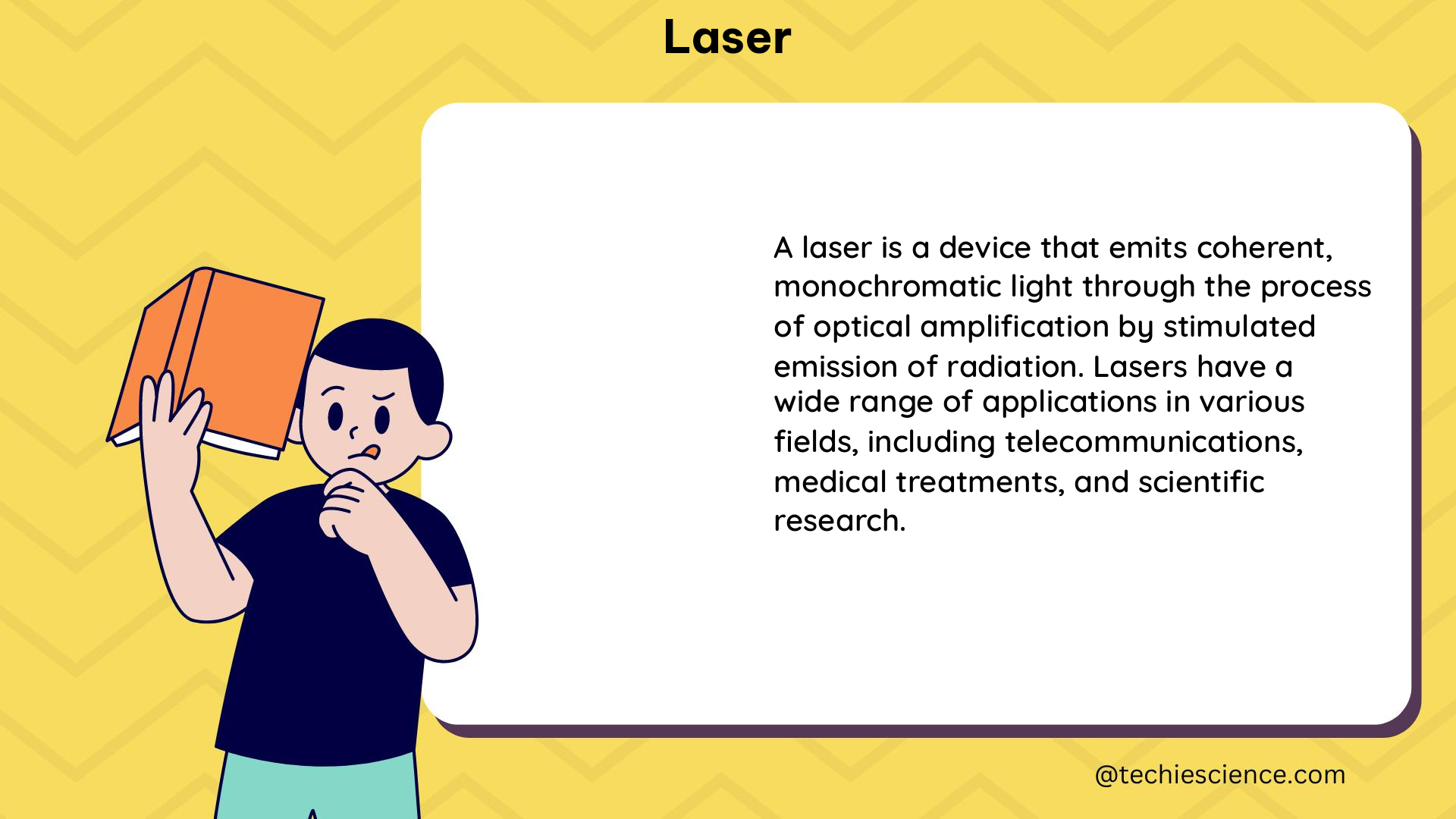Lasers are versatile and powerful tools that have revolutionized numerous fields, from scientific research to industrial applications. Understanding the key parameters and performance characteristics of lasers is crucial for any science student or enthusiast looking to delve into the world of laser technology. In this comprehensive guide, we will explore the intricacies of laser performance, providing you with a deep dive into the technical specifications and measurable data points that define the capabilities of these remarkable devices.
Wavelength: The Cornerstone of Laser Performance
The wavelength of a laser, measured in nanometers (nm) or micrometers (μm), is a fundamental parameter that determines the absorption, transmission, and reflection characteristics of materials. This parameter is crucial in various applications, such as:
- Spectroscopy: The specific wavelength of a laser can be used to excite and study the electronic transitions of atoms and molecules, enabling advanced spectroscopic techniques.
- Laser Cutting and Welding: The wavelength of a laser affects its interaction with different materials, influencing the efficiency and precision of cutting and welding processes.
- Laser Printing: The wavelength of the laser in a laser printer determines the size and resolution of the printed image, as it affects the way the toner interacts with the paper.
To understand the significance of wavelength, consider the following equation:
E = h * c / λ
Where:
– E is the energy of a photon
– h is Planck’s constant (6.626 × 10^-34 J·s)
– c is the speed of light (3 × 10^8 m/s)
– λ is the wavelength of the photon
This equation demonstrates the inverse relationship between the wavelength and the energy of a photon, highlighting the importance of selecting the appropriate wavelength for specific applications.
Power and Energy: Driving the Laser’s Capabilities

Power, measured in watts (W), is a crucial parameter that determines the laser’s ability to perform various tasks. High-power lasers are often used in industrial processes, such as cutting, welding, and additive manufacturing, where precise power level control is essential.
On the other hand, energy, measured in joules (J), is particularly relevant for pulsed lasers. The energy of a laser pulse is the product of the power and the pulse duration, and it is a critical parameter for applications like laser-induced breakdown spectroscopy (LIBS) and laser-based material processing.
The relationship between power and energy can be expressed as:
Energy (J) = Power (W) × Pulse Duration (s)
Understanding the power and energy requirements of a laser is crucial for selecting the appropriate laser source and ensuring optimal performance in various applications.
Repetition Rate and Pulse Duration: Timing the Laser’s Precision
For pulsed lasers, the repetition rate, measured in hertz (Hz), indicates the number of pulses per second. This parameter is essential in applications where the timing and synchronization of laser pulses are critical, such as in laser-based communication systems or time-resolved spectroscopy.
Pulse duration, or pulse width, is often expressed as a percentage of the period between pulses and can be measured in seconds (s). This parameter is crucial in determining the peak power of a laser pulse, as well as the temporal resolution of the laser’s output. Shorter pulse durations can lead to higher peak powers, enabling applications like laser-induced plasma generation or ultrafast spectroscopy.
The relationship between repetition rate and pulse duration can be expressed as:
Period (s) = 1 / Repetition Rate (Hz)
Pulse Duration (s) = Percentage of Period
Carefully selecting the appropriate repetition rate and pulse duration is essential for achieving the desired performance in various laser-based applications.
Divergence: Controlling the Laser’s Beam Spread
Divergence, measured in milliradians (mrad) or degrees, is a crucial parameter for free-space laser communication and other applications where the laser beam needs to be directed over long distances. Divergence describes the angular spread of the laser beam as it propagates, and it is influenced by factors such as the laser’s wavelength, beam quality, and the design of the optical system.
The divergence of a laser beam can be calculated using the following equation:
Divergence (mrad) = Beam Diameter (mm) / Focal Length (m)
Understanding and controlling the divergence of a laser beam is essential for ensuring efficient energy transfer and maintaining the desired beam size at the target location.
Beam Profile: Visualizing the Laser’s Power Distribution
Beam profile measurement is a crucial step in understanding the power distribution of a laser beam. This analysis reveals whether the beam has a Gaussian or flat-top profile, and it can also identify any hot spots that could lead to overheating or underheating in applications like 3D printing.
One of the key parameters used to quantify beam quality is the M2 factor, which is a measure of how close the laser beam is to an ideal Gaussian beam. The M2 factor ranges from 1 (for a perfect Gaussian beam) to infinity (for a highly multimode beam). A lower M2 value indicates a higher-quality beam, which is essential for applications that require precise control over the laser’s energy distribution.
The M2 factor can be calculated using the following equation:
M2 = (π * Beam Diameter * Divergence) / (4 * λ)
Where:
– M2 is the beam quality factor
– Beam Diameter is the diameter of the laser beam
– Divergence is the angular divergence of the laser beam
– λ is the wavelength of the laser
Analyzing the beam profile and understanding the M2 factor are crucial for optimizing the performance of a laser in various applications.
Technical Specifications for a Laser DIY Project
When embarking on a laser DIY project, it is essential to consider the following technical specifications to ensure successful implementation and optimal performance:
-
Wavelength Range: Ensure that the sensor used for beam profiling is sensitive to the specific wavelength of the laser. If necessary, consider using beam profiling accessories like UV converters or IR adaptors to accommodate different wavelength ranges.
-
Sensor Dimension and Pixel Pitch: The sensor should be at least three times the largest diameter of the beam, and the smallest beam should fit within at least 10 pixels. This ensures that the beam profile is accurately captured and analyzed.
-
D4σ (Second Moment Width): This parameter represents the diameter that contains 86.5% of the total beam power. It is calculated from the second moment of the beam profile and is a crucial metric for understanding the power distribution of the laser beam.
-
Beam Quality (M2): As mentioned earlier, the M2 factor is a measure of the beam quality, with M2=1 indicating the best beam quality. Ensuring a low M2 value is essential for applications that require precise control over the laser’s energy distribution.
-
Power and Energy Considerations: Carefully select the appropriate laser source based on the power and energy requirements of your project. Consider the specific tasks and applications you intend to use the laser for, and choose a laser that can deliver the necessary performance.
-
Pulse Duration and Repetition Rate: If your laser is pulsed, ensure that the pulse duration and repetition rate are suitable for your application. Adjust these parameters to achieve the desired peak power and temporal resolution.
-
Beam Divergence: Understand the divergence characteristics of your laser and how they may impact the beam size and energy distribution at the target location. Adjust the optical system, if necessary, to control the beam divergence.
By carefully considering these technical specifications and understanding the key measurable and quantifiable data points, you can ensure the successful implementation and optimal performance of your laser DIY project.
Conclusion
Mastering the intricacies of laser performance is essential for any science student or enthusiast looking to delve into the world of laser technology. In this comprehensive guide, we have explored the crucial parameters that define the capabilities of lasers, including wavelength, power, energy, repetition rate, pulse duration, divergence, and beam profile.
By understanding the relationships between these parameters and the underlying physics, you can make informed decisions when selecting and configuring laser systems for your specific applications. Whether you’re working on a laser DIY project or conducting advanced scientific research, this guide provides you with the technical knowledge and practical insights to navigate the world of lasers with confidence.
Remember, the journey of mastering lasers is an ongoing one, as new advancements and applications continue to emerge. Stay curious, keep learning, and embrace the ever-evolving landscape of laser technology. Happy exploring!
References
- Ophir Photonics. (n.d.). 5 Situations Where Laser Performance Matters. Retrieved from https://www.ophiropt.com/en/n/5-situations-laser-performance
- Gentec-EO. (2019, May 23). Spot Size of Laser Beam: What You Need to Know. Retrieved from https://www.gentec-eo.com/blog/spot-size-of-laser-beam
- Arroyo Instruments. (2021, April 28). Understanding Laser Power Stability: What You Need to Know. Retrieved from https://www.arroyoinstruments.com/blog/understanding-laser-power-stability-what-you-need-to-know/
- Xometry. (n.d.). Laser Beam Quality: What You Need to Know. Retrieved from https://www.xometry.com/resources/sheet/laser-beam-quality/

Hi, I am Sanchari Chakraborty. I have done Master’s in Electronics.
I always like to explore new inventions in the field of Electronics.
I am an eager learner, currently invested in the field of Applied Optics and Photonics. I am also an active member of SPIE (International society for optics and photonics) and OSI(Optical Society of India). My articles are aimed at bringing quality science research topics to light in a simple yet informative way. Science has been evolving since time immemorial. So, I try my bit to tap into the evolution and present it to the readers.
Let’s connect through